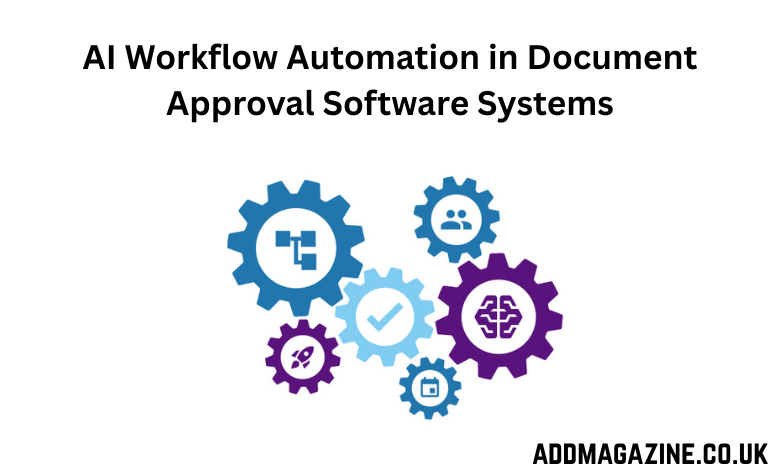Organizations face a constant challenge of managing documents efficiently. Manual processes for approvals can be slow, prone to errors, and often cause delays in important decisions. This is where AI workflow automation and a document approval software system come into play. By combining artificial intelligence with smart workflow management, businesses can streamline document approvals, reduce mistakes, and save valuable time. In this article, we will explore how AI workflow automation works in document approval systems, its benefits, and why companies should adopt it.
What is AI Workflow Automation?
AI workflow automation refers to the use of artificial intelligence to automate repetitive tasks and decision-making processes within a workflow. Instead of relying on manual interventions, AI can intelligently route tasks, predict bottlenecks, and ensure that approvals are completed on time. In a document approval software system, AI can automatically identify the relevant approvers, check for missing information, and flag errors before the document moves to the next stage.
For example, in a purchase requisition process, AI can verify whether the budget is available, ensure compliance with internal policies, and route the request to the correct manager for approval. This not only reduces human errors but also accelerates the entire approval cycle.
Benefits of AI Workflow Automation in Document Approval
1. Reduce Errors
Manual document approvals are often prone to mistakes. Approvers may overlook missing information, misinterpret data, or accidentally approve incorrect documents. With AI workflow automation, these errors are significantly reduced. The system can automatically validate data, detect inconsistencies, and alert the user before the document moves forward. This ensures that only accurate and complete documents are approved, minimizing the risk of costly mistakes.
2. Save Time
Traditional document approval processes can take days or even weeks, especially when multiple approvers are involved. AI workflow automation speeds up this process by routing documents intelligently and reminding approvers of pending tasks. Automated notifications and task prioritization help reduce delays, allowing employees to focus on more strategic activities rather than spending time chasing approvals.
3. Improve Transparency
One of the key advantages of using AI in document approval software systems is improved transparency. Every action taken on a document is recorded, making it easy to track the status of approvals. Managers can quickly see where a document is stuck and take corrective actions if necessary. This visibility helps maintain accountability and ensures that no document gets lost or delayed in the workflow.
4. Enhance Compliance
Many industries require strict compliance with internal policies and legal regulations. AI workflow automation can enforce these rules automatically by checking documents against predefined criteria. For example, in financial approvals, the system can ensure that all necessary signatures are obtained and that approvals follow the correct sequence. This minimizes the chances of non-compliance and helps avoid potential legal complications.
5. Scalable Solution
As businesses grow, the volume of documents that require approvals increases. Manual processes struggle to keep up, leading to bottlenecks and inefficiencies. AI workflow automation provides a scalable solution that can handle large volumes of approvals without compromising on speed or accuracy. Whether a company processes a few documents per day or thousands, the system adapts seamlessly.
How to Implement AI Workflow Automation in Document Approval
Step 1: Identify the Workflow
Start by identifying the document approval workflows in your organization. Common workflows include purchase requisitions, expense approvals, HR forms, and legal contracts. Understanding the steps involved in each workflow is critical to designing an automated system.
Step 2: Choose the Right Software
Select a document approval software system that offers AI-powered workflow automation. Look for features such as intelligent routing, error detection, approval tracking, and integration with other business tools. A good system should allow customization to fit your organization’s specific needs.
Step 3: Define Rules and Approvals
Set up rules for document approvals, including required approvers, approval sequences, and validation checks. AI workflow automation relies on these rules to route documents correctly and flag any issues automatically.
Step 4: Train the AI
Some AI systems require initial training to understand patterns in document approvals. This may involve reviewing past approvals and setting up machine learning models to predict workflow bottlenecks and approval behavior.
Step 5: Monitor and Optimize
After implementation, continuously monitor the workflow to identify areas for improvement. AI systems can provide insights into delays, error rates, and overall efficiency. Use this data to optimize workflows and improve productivity further.
Conclusion
AI workflow automation in document approval software systems is no longer a luxury; it has become a necessity for businesses that want to stay competitive. By reducing errors, saving time, improving transparency, and ensuring compliance, AI-powered document approval systems transform manual, error-prone processes into efficient, scalable workflows. Companies that adopt this technology can focus more on strategic tasks, enhance productivity, and accelerate decision-making.
If your organization still relies on manual document approvals, now is the perfect time to explore AI workflow automation and a document approval software system to streamline your operations and stay ahead in the digital era.




